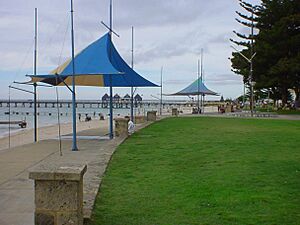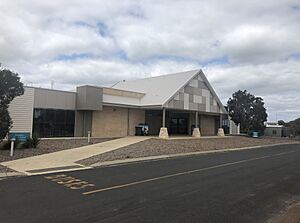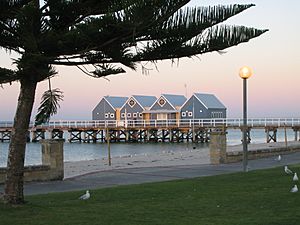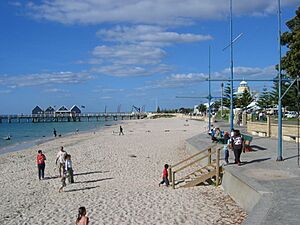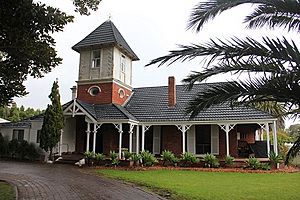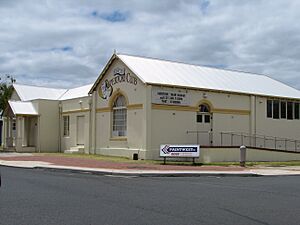Busselton facts for kids
Quick facts for kids BusseltonWestern Australia |
|||||||||
|---|---|---|---|---|---|---|---|---|---|
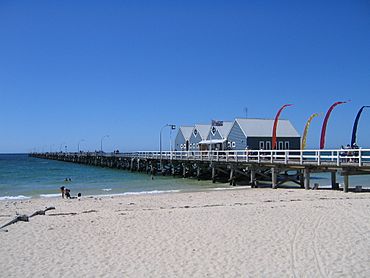
At 1,841 metres (6,040 ft), the Busselton Jetty is the longest wooden jetty (pier) in the Southern Hemisphere.
|
|||||||||
| Population |
|
||||||||
| • Density | 540/km2 (1,400/sq mi) | ||||||||
| Established | 1832 | ||||||||
| Postcode(s) | 6280 | ||||||||
| Elevation | 4 m (13 ft) | ||||||||
| Area | 50 km2 (19.3 sq mi) | ||||||||
| Time zone | AWST (UTC+8) | ||||||||
| Location |
|
||||||||
| LGA(s) | City of Busselton | ||||||||
| State electorate(s) | Vasse | ||||||||
| Federal Division(s) | Forrest | ||||||||
|
|||||||||
Busselton is a city in the South West part of Western Australia. It's about 220 kilometres (137 miles) south-west of Perth, the capital city. Busselton has always been a popular holiday spot for people in Western Australia.
After the Busselton Port closed in 1972, and the nearby Margaret River wine region became famous, tourism grew a lot. Now, tourism, along with shops and services, is the main focus for the city. Busselton is most famous for the Busselton Jetty, which is the longest wooden jetty (or pier) in the Southern Hemisphere!
Contents
Busselton's Past: A Look Back in Time
Early Days: Before Europeans Arrived
For at least 40,000 years before 1832, the Busselton area was home to the Noongar Aboriginal people. They belonged to the Wardandi and Bibulman groups. Many towns in the Busselton area, like Wonnerup and Yallingup, still have their original Noongar names today.
European Exploration and Settlement
In 1801, a French expedition led by Nicholas Baudin explored the coast of Western Australia. Baudin named Geographe Bay and Cape Naturaliste after his ships. He also named the Vasse River after a sailor, Thomas Vasse, who was lost at sea.
Busselton was one of the first places settled by Europeans in Western Australia. The Bussell family arrived in 1832. They found the land beautiful and green. The Bussells started a cattle farm called "Cattle Chosen," which became very successful.
The town was officially named Busselton in June 1835, after the Bussell family. The town grew, and by 1839, it had 77 people. A post office opened in 1842, and St Mary's Church was built in 1845.
In the early days, whaling ships from different countries visited the area. They traded goods with the settlers. As time went on, the need for whale oil decreased, and these visits stopped.
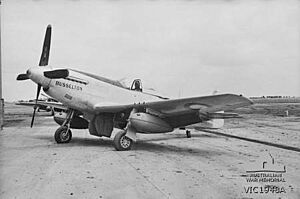
Timber and Railways
Busselton became an important port because it was close to tall timber forests. Timber was exported from jetties built at Wonnerup, Busselton, and Quindalup. Only the Busselton Jetty remains today.
In the 1850s, convicts arrived in Western Australia and helped with the timber industry. Western Australia's first railway line was built near Busselton in 1871. It was used to transport timber. By the 1880s, Busselton had regular mail and coach services. A passenger train service to Bunbury started in 1894 and ran until 1985.
Busselton as a Holiday Spot
By the early 1900s, Busselton was well-known as a resort town. The railway helped more people visit. Caves in the Leeuwin-Naturaliste National Park area, like Ngilgi Cave, were discovered and became popular. People loved camping and seaside holidays along the coast.
The town grew a lot between 1923 and 1926 due to the Group Settlement Scheme, which brought many new people to the area. During World War II, many men from Busselton joined the army, navy, and air force. Busselton also had an Air Force training base. A P-51 Mustang fighter plane was even named Busselton to honour the town's support for the war effort.
In the 1950s and 60s, more holiday facilities were built. The Margaret River wine region also started to grow, bringing even more tourists to Busselton. The Busselton port closed in 1972. From the 1970s onwards, Busselton became a major tourism and retirement centre. In 2012, the Shire of Busselton officially became a city!
Where is Busselton? (Geography)
Busselton is located in the South West region of Western Australia. It's about 220 kilometres (137 miles) south-west of Perth. The city includes the main centre and suburbs like Abbey, Broadwater, and Geographe.
To the north, Busselton is next to Geographe Bay. The Vasse River flows through the city into the Vasse-Wonnerup Estuary. The city's western edge is near Caves Road, which leads to the town of Dunsborough. The closest city to Busselton is Bunbury, which is about 52 kilometres (32 miles) north-east.
Busselton's Weather (Climate)
Busselton has a climate with warm to hot summers and cooler, wetter winters. This is similar to a Mediterranean climate. In summer, the average daily high temperature is around 28-30°C (82-86°F). In winter, temperatures are cooler, usually between 7-18°C (45-64°F).
Busselton gets about 794.5 millimetres (31 inches) of rain each year. The wettest time is from May to September.
Who Lives in Busselton? (Demographics)
In 2021, Busselton had a population of 27,233 people. The average age in Busselton is 45, which is a bit older than the national average in Australia.
Most people in Busselton (75.9%) were born in Australia. Other common birthplaces include England (7.8%), New Zealand (2.3%), and South Africa (1.1%). English is the main language spoken at home by most residents (89.5%).
The most common jobs in Busselton are in places like hotels and resorts (accommodation), cafes and restaurants, and supermarkets. Some people also work in iron ore mining on a fly-in fly-out basis, meaning they travel to work in other areas.
Experts believe that by 2050, Busselton's population could grow to between 50,000 and 70,000 people.
Getting Around Busselton (Transport)
The Bussell Highway connects Busselton to Bunbury and Augusta. The Vasse Highway goes from Busselton to Pemberton. Caves Road offers a beautiful scenic drive from Busselton to Augusta. In 2000, the Busselton Bypass road opened, making it easier to get around the city.
Busselton has a local bus service called TransBusselton with three routes. You can also catch coach services from South West Coach Lines and Transwa to other towns and Perth. Busselton also has its own airport, the Busselton Margaret River Airport.
Busselton's Economy and Fun Things to Do
Busselton's main industries are services like retail, manufacturing, and recreation. The economy has shifted from farming to tourism as more people have moved to the area and tourism has grown.
Tourism: Exploring Busselton's Attractions
There are many interesting places to visit in the Busselton region. Busselton Beach is famous for its calm, turquoise-coloured water and white sand. The City of Busselton calls itself "The Events Capital of WA" because it hosts so many events!
Busselton Jetty
The Busselton Jetty is the longest wooden jetty in the Southern Hemisphere, stretching 1,841 metres (6,040 feet) out into the sea. Building the jetty started in 1864, and it was extended many times until the 1960s.
It stopped being used for ships in 1972. After being damaged by a cyclone in 1978 and a fire in 1999, it was repaired and improved. Since 2003, visitors can ride a tourist train along the jetty, visit an underwater observatory, and learn about its history at an interpretive centre.
Wonnerup House
The Wonnerup House was built in 1859 by the Layman family, who were early settlers. The original house burned down in 1858. The property also has older buildings like the dairy and kitchen, which survived the fire. Across the road are the Teacher's House (1885) and School (1873). Since 1973, the National Trust of Australia has run Wonnerup House as a museum for visitors.
Old Butter Factory / Busselton Museum
The Old Butter Factory was built in 1918. It was Western Australia's first butter factory and also made ice for locals and fishermen. It stopped making butter in 1952. In 1974, the Busselton Historical Society opened the Busselton Museum there. The building was damaged by fire in 2018 but has since been repaired and reopened.
St Mary's Church
St Mary's (Church of England), built in 1844–1845, is thought to be the oldest stone church in Western Australia. It has a graveyard with graves dating back to 1841.
Ithaca (Villa Carlotta)
Ithaca, also known as Villa Carlotta, was built in 1896. It has a two-storey tower. It was first a private home, then a Catholic convent, a school, and a hotel. Today, it is a motel.
Weld Hall
Weld Hall was built in 1881. It is one of the oldest buildings in Busselton. It's a brick building with a galvanised roof, built in a Victorian Italianate style. It is recognised for its important history and cultural value to the community.
Augusta-Busselton Heritage Trail
This trail follows the path taken by the first settlers in the 1800s from Augusta to Busselton. It's over 100 kilometres (62 miles) long, starting at the Busselton Jetty.
Learning in Busselton (Education)
Busselton has nine schools. Six are government schools (four primary schools and two high schools). Three are private schools that teach both primary and high school students. These include St Mary MacKillop College and Georgiana Molloy Anglican School. The only local college is the South Regional TAFE. Busselton also has a learning centre for Edith Cowan University students who study from a distance.
Fun and Games (Recreation and Culture)
Sports
Busselton has a leisure centre, a golf club, tennis courts, and a skate park. The Busselton Football Club plays in the local football league.
Some exciting sports events in Busselton include:
- Geographe Bay Race Week (sailing)
- Busselton Festival of Triathlon
- Ironman Western Australia Triathlon
- The Busselton Jetty Swim
- The Australian HPV Super Series race
Arts
Busselton has the ArtGeo Cultural Complex. This place includes an art gallery, a theatre, an artist's workshop, and a craft store. It also has the old Busselton Court House and Police Complex, which includes an old courthouse and post office. These buildings have a lot of history.
The ArtGeo Gallery is in a building that used to be a bank, built in 1931. The complex also features life-sized sculptures by Greg James. These sculptures show important figures from Busselton's history, like the Whaler's Wife, Timber Worker, and Gaywal (an Aboriginal leader).
Busselton also hosts the famous CinefestOZ film festival. A new Performing Arts Centre, named "Saltwater" to honour the Wardandi people, is expected to open in early 2024.
Other Events
Other popular events in Busselton include:
- Festival of Busselton
- Make Smoking History Forest Rally (car rally)
- Busselton Agricultural Show (since 1861)
- South West Craft Beer Festival
Media
Busselton has two local weekly newspapers: the Busselton Dunsborough Mail and the Busselton Dunsborough Times. You can also buy the state newspapers, The West Australian and Sunday Times.
Busselton receives three main commercial TV channels: Seven, WIN, and Ten. You can also watch the public channels, ABC and SBS.
Sister City
Busselton has a sister city relationship with:
 Sugito, Saitama, Japan
Sugito, Saitama, Japan
Images for kids
See also
 In Spanish: Busselton para niños
In Spanish: Busselton para niños



